Iranian Traditional Music and Instruments
Iranian Traditional Music and Instruments
Without a doubt, music is one of the most incredible and stupendous creations of civilization. According to some claims, music is a superior art and one of the wonders of our world; a phenomenon that is fully blended and integrated with the world’s politics, cultures, religions, visual art such as films, and even wars.
Music by some’s definition is to express emotions through rhythm and sound; and the knowledge of the way that harmony of sounds can evoke an uprising of sensations.
Let us take a quick look through some of the great sayings regarding music:
“Without music life would be a mistake”
Friedrich Nietzsche
“Music is a moral law. It gives soul to the universe, wings to the mind, flight to the imagination, and charm and gaiety to life and to everything.”
Plato
“Music is the one incorporeal entrance into the higher world of knowledge which comprehends mankind but which mankind cannot comprehend.” and
“Where poetry ends there music begins.”
Beethoven
Such strong praise by such imminent men indicates the high esteem in which music is held globally.
Music in Iran
According to historical evidence, music in Iran dates back to centuries ago, to the time of Ancient Persia. The history of music in Iran is a complex one, from the references by Persian philosophers and writers, and the popularity of music in the royal courts, to the official and formal bans and complete prohibitions against this form of art.
Iran is nonetheless the origin of a rich and diverse tradition of music, which constitutes an important aspect of the country’s culture and art. Almost all of the Iranian people possess their own unique type of traditional music which takes part in making up the mesh of this art’s tradition in the land.
Moreover, genres of music such as rap, pop, etc have been integrated into Iran’s culture, where Persian and foreign tongues mix in an array of sounds and words to appeal to particularly the younger audiences.

Iranian Traditional Music
Iranian Classical Music, also known as Iranian Traditional Music, or “Dastgāhi,” (دستگاه in Persian) comprises musical modal systems, tunes, and lyrics that have passed from generation to generation from the time of the birth of Jesus Christ.
What has reached the Iranians of today has withstood the ravages of time and encompassed all additions and modifications that cultures in Central Asia, Afghanistan, Pakistan, the Republic of Azerbaijan, Armenia, Turkey, and Greece have brought to it. In turn, it has left an influence on those cultures and their music in its own right.
It can be stated that the golden age of music in Iran was at the height of the Sassanid Era, during the reign of Khosrow Parviz and Bahram V. The renowned musicians of this age include Barbod, Nakisa, and Ramtin.
Iranian music can be put into categories called Dastgah. Each Dastgah of Iranian music is a succession of Iranian major seconds, meant to evoke a particular sensation in the listener. Overall, Iranian folk and traditional music is composed of seven Dastgahs. Furthermore, the original musical “Radif” (ردیف Persian)was added to the UNESCO list of intangible heritage in October 2009.
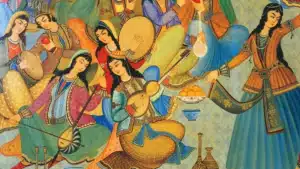
Instruments
A musical instrument can indeed be any object that can produce sound, but by definition, an instrument is a device particularly manufactured to perform music. The oldest instrument utilized by civilization is ostensibly, the human voice.
That aside, the oldest instruments were probably percussion instruments and wind instruments occupy the third place. The sound that an instrument produces depends wholly on the material, design, and precision of its build.
Iran’s Musical Instruments
Iranians used different types of musical instruments throughout the ages. Iranian musical instruments can be categorized in many ways, but one very common method is to categorize them based on the material from which the components are built. Iran’s traditional instruments are made of clay, metal, and wood; and based on the way they produce sound they fall into the three categories of wind, string, and percussion.
- Wind instruments such as Ney(نی), Quarter tone clarinet(قره نی), Bagpipes(نی انبان), Korna(کرنا), Balaban(بالبان), Dozaleh(دوزله), Sorna(سرنا), and many more.
- String instruments fall into three groups: The first, plucked string instruments, which comprise the Tar(تار), Setar(سه تار), Dutar(دوتار), Oud(عود), Tanbur(تنبور), Komuz(چگور), Rubab(رباب), Qanun(قانون), Harp(چنگ), etc. Next are bowed string instruments, such as Ghaychak(قیچک), and Kamancheh(کمانچه). Lastly are the struck string instruments, and the most renowned in Persian, called Santur(سنتور).
- Persian percussion instruments are the Drums(طبل), Dayereh(دایره), Dohol(دهل), Tombak(تنبک), Naqareh(نقاره), Senj(سنج), Daf(دف), Kus(کوس), and so forth.
This wide array of instruments underwent change. Many of these items were gradually modified into other forms, some fell out of use, and some sustained only the smallest of tweaks.
Metallic instruments, made of copper and brass, are made by casting and hammering. Clay instruments are the result of the art of pottery. Some tombak instruments (drums) are made of clay bowels covered with hide.
Wooden instruments are made by carving and cutting. This category contains the most diverse shapes and forms of instruments, and the mental shape that “Iranian traditional instrument” recalls, mostly belongs to this category. Most string and some percussion instruments are made of wood.
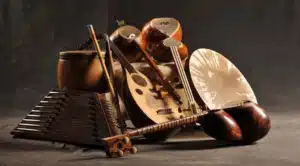
Let us now look at a few widely-used musical instruments of Iran
Santur
Santur is a wholly Iranian instrument from the family of string instruments that are struck to produce sound. It is shaped as an isosceles triangle made of wood and metal and is played while sitting down, using special plectrums. According to some, Santur is one of the oldest of Iranian traditional instruments.
The most familiar shape of Santur has 72 strings, divided into 4 groups. Most commonly, there are more than 3 octaves on one note of this instrument.
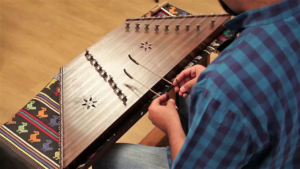
Tar
Tar is an Iranian string instrument played with a pluck. In Iran, and other lands of the Middle East such as Tajikistan, Republic of Azerbaijan, Armenia, Georgia, and other countries near Caucasus, playing folk music with this instrument is widespread. Iranian experts believe that tar has common roots among all Iranian ethnic groups.
In the past, Iranian Tar had five wires (or five strings). Gholam Hossein Darvish or Darvish Khan, one of the prominent masters of music, added a sixth string to it, which is still used.It is noteworthy that this Iranian instrument was registered by UNESCO under the name of Azerbaijan Tar, a matter which was protested by the Iranian artistic community.
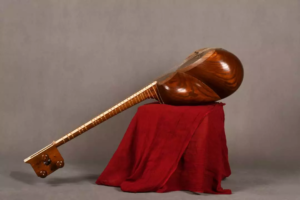
Setar
Setar is also a string instrument; built with material such as metal, and nylon strings. It produces sound by the plucking of its string with the nail of the artist’s index finger. Previously, Setar was considered to belong to the family of Tanbur, but no longer. This instrument is played while seated, but due to its lightweight, you can play it standing up too.
Setar comprises four metal strings in different thicknesses built of stainless steel and brass. The sound that it produces is soft and velvety; and since the sound is produced directly by the touch of the finger of the player, it directly connects to the soul and mind of its owner. This is the reason why Setar is allegedly the instrument of the times of loneliness, thus gaining the special attention of Sufis.
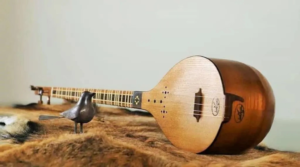
Tanbur
Tanbur is an instrument with a long, pear-shaped handle, widely made from mulberry tree. Tanbur is the oldest plucked instrument; that is, it is the first instrument with a long handle and a string.
Musicians play Tanbur using four fingers of the right hand and do not use a pluck. The technique for playing it with the left hand is similar to other instruments that have a handle such as Tar and Setar.
Tanbur is one of the oldest instruments of Iran to hold a spiritual consequence. Based on archeological finds, we can claim the origin of this instrument goes 6000 years back. One of the most important historical sources is a figurine located near the Tomb of Daniel in Susa.
Perhaps we can never truly determine the date of origin of this Iranian musical instrument, however, we can say for certain that Tanbur appeared many centuries before the birth of Islam.
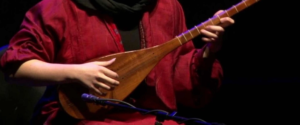
Dutar
Dutar is one of the Iranian string instruments that has two strings(Tar means string, and the number two translates to Du in Persian). This instrument is hardly ever played with a pluck, rather artists use their fingers to play it.
Dutar dates back to millennia ago. Nowadays, this instrument has gained quite a bit of popularity and most cities of the north of Khorasan Province, and Mazandaran, as well as the regions populated by the Turkmen.
The proficiency and dexterity of the production of the Iranian Dutar has been registered in UNESCO’s list of Intangible Cultural Heritage. In addition, the folk music of Khorasan, mainly produced with this instrument, is registered in the list of Intangible Cultural Heritage, separately.

Oud (Barbat)
This is an Iranian string instrument that is popular in all of the Middle East and the Arabic-speaking countries of the north of Africa. The name Oud is what they call it in Arabic. In the manufacture of this instrument, bone, wood, and strings are used.
Barbat is a significant and old Iranian traditional musical instrument that comprises 10 strings which are tuned in pairs. Barbat produces the lowest sound among Iranian string instruments.
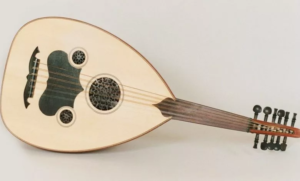
Qanun
The Qanun is a musical instrument belonging to the old family of Cythare, taken to Europe in the middle ages under the name Canon, or Miocanon. Qanun is shaped as a trapezius made of bone, skin, wood, metal, and string. To play it, the musician places it in their lap with the longer side towards their body and utilizes their index fingers (equipped with wearable pluck).
Some attribute the invention of the Qanun to Plato, while others claim it was designed by Al Farabi. Neither of these claims have a documented basis, and sadly, the origin of this creation remains indeterminate.
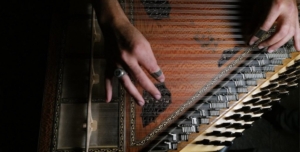
Kamancheh
Kamancheh is a bowed musical instrument of Iran. Built from wood, metal, and bone; its length reaches approximately 75 cm. To play this instrument, the musician holds it vertically while sitting down. Kamanche was registered into UNESCO in the year 1396 by the aid of the Ministry of Cultural Heritage of Iran.
Before playing the violin had become widespread in Iran, Kamanche was made with silk or catgut and could not withstand severe tuning. Violin strings substituted these materials quickly when they became popular in Iran.
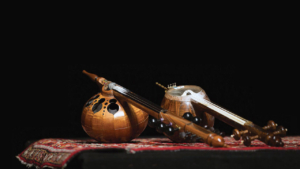
Ghaychak
Gheychak is an instrument of Iranian traditional music that, similar to Kamanche, is played with a bow. The bowl of this instrument is made from walnut trees or mulberry tree wood, and the strings are metal.
Ghaychak goes way back and was popularly used in Iran’s folk music. Playing this instrument is similar to playing cello; indeed, to play its bigger counterpart – the Bass Ghaychak, or Gheychak-e Bam- the bow of a cello may be used.
Playing Ghaychak is most prevalent in the south-eastern regions of Iran, particularly Sistan and Baluchestan Province, Kerman, and Hormozgan. In the northern areas of Afghanistan also, ghaychak has substantial popularity in folk and traditional music.

Rubab
Rubab is an old instrument dating back to the Islamic area, in the region of Sistan and Baluchestan, and Afghanistan. The Persian name for this instrument is Ravaveh. This is the most ancient of Iran’s instruments and it is seen illustrated in many of Iran’s petroglyphs.
Rubab comprises 6 strings, in 3 pairs that are turned together.
The strings were customarily made of catgut in the past, however, nowadays, they are made of synthetic material, with a metal coat, similar to that of guitars strings.
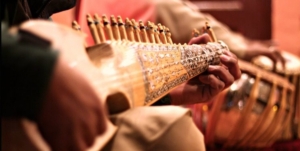
Daf
Daf (frame drum) is a percussion instrument in Iranian traditional music composed of a wooden ring, with a thin skin laid on top. Daf is played by the tap of fingers. This is an instrument similar in shape to Dayereh, however, it is larger and produces a lower sound.
Daf and Dayereh can be seen in the miniature artwork of the Mughal Empire and Safavid Era.
The Safavid era paintings exhibit Daf along with Ney, in ceremonies called Sama. In ancient poetry, also, these two instruments surface together.
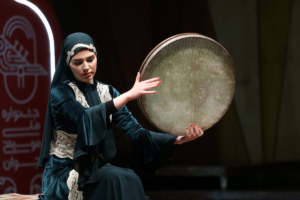
Dayereh
In Persian, the word “dayereh” means a circle. Dayereh is a percussion instrument similar to Daf, except that Dayereh lacks the small metal chains that are attached to the wooden ring of Daf.
Dayereh also comes in a smaller size than the other. These differences result in the rather different sounds they produce. Afghanistan, Azerbaijan, Uzbekistan, Tajikistan, and Xinjiang Uyghur of China.
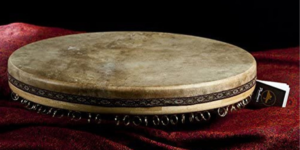
Timbrel
In Farsi, a timbrel is called “Dayereh Zangi,” as the word Zangi means bells in Farsi, and Dayereh, well, as mentioned above, a circle. This percussion instrument is just like a Dayereh, with the addition of bells; small metallic discs that are put inside clefts carved inside the wood.
A historic mural of Isfahan’s Chehel Sotoon showcases the playing of Dayereh Zangi in the Safavid Era. This instrument is still popularly played in Iran’s celebrations, events, carnivals, and concerts; sometimes even in symphonic or jazz orchestras.
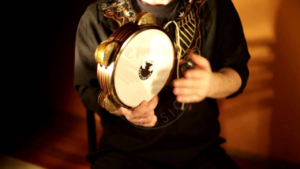
Tombak
Tombak or Tonbak is one of the most famous of Iran’s musical instruments. Another name for this percussion instrument is Zarb, which means to strike, in Farsi. This instrument is made of the wood of maple, mulberry, and walnut trees.According to some of our oldest historians, such as Al-Farabi, the fountainhead of Tombak was the western region of Persia.
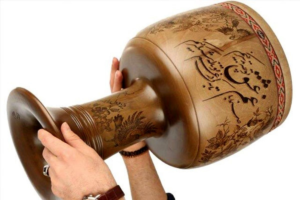
Ney
Ney is a reedless wind instrument that cannot be tuned; hence the player must opt for another Ney of different length to produce the sounds required for a solo or duet.
This wind instrument is made up of straw – translated to Ney in Farsi- that usually has 7 segments, and 6 tone holes, which is why another name for this type of Ney, is Ney-e Haft-Band; with Haft meaning 7 in Farsi(if this reminds you of Haft Sin, you are quite right!). The range of Ney is about 2.5 octaves.
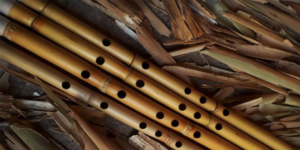
Sorna
Another member of the family of wind instruments played all across Iran. There exist a few types of Sorna, namely the Bakhtiyāri, the Azerbaijani, and the Khorasani.
In Iran, Sorna is often accompanied by the sound of Dohol or Naqareh. We must note that in Persian, these instruments are usually played during special ceremonies; for instance, in Lorestan and Kurdistan, to announce a person’s death, they play Dohol and Sorna.
In the northern region of Iran, to accompany a performance of acrobatics it is customary to play Sorna. In West Azerbaijan Province, in wedding celebrations, especially during the transitional ‘“dance with the rod,” it is customary to play Sorna.
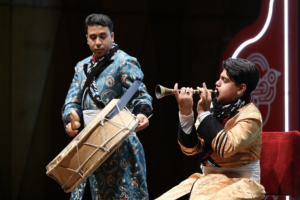
Korna
This is an ancient wind instrument of Iran, made and played in different shapes. The Korna is as old as the ancient carnyx and likely of the same use in ancient times. The predominant Kornas of Iran are the Korna of the north, Gilan, that of Mashhad, and that of Bakhtiyār. The instrument is now most widely played in Khuzestan, Fars, Chaharmahal, and Gilan.
According to archeological finds from the Achaemenid Era, Korna dates back to 2500 thousand years ago. One of such object excavated is a bronze Korna, found in the tomb of Darius III.
This Korna currently resides in the Persepolis Museum, popularly named the Achaemenid Korna. Since objects of value and worth were usually buried at the grave of kings, it seems that the Korna held a special place in the culture of the Achaemenid; as an object more than a mere instrument of music, rather a symbol of unity and of power.
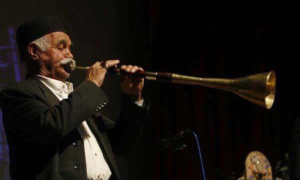
Bagpipes (Ney Anban)
Ney Anban is one of the oldest instruments to have been devised, and it exists in many countries, although maybe in slightly dissimilar shape. In Iran, bagpipes are most common in southern cities. They’re called “Kheek-Nay,” which translates to “pipe of the abdomen.”
This instrument is attached to a sac called “Anban” which is filled with air and pressed out gently with the jabs of the arm.
The particular bagpipe of Iran, Ney Anban, was registered into Iran’s Intangible Cultural Heritage List of UNESCO, currently pending evaluation for UNESCO World Heritage List.


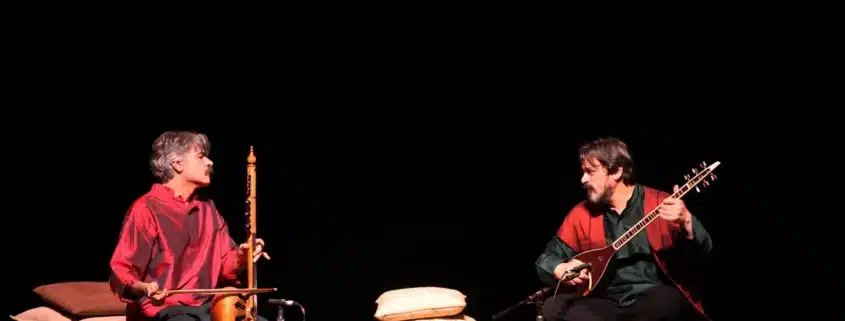

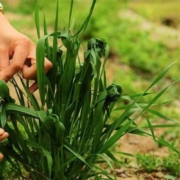


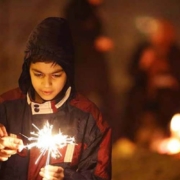
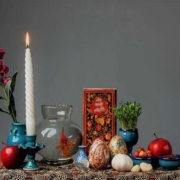

Leave a Reply
Want to join the discussion?Feel free to contribute!